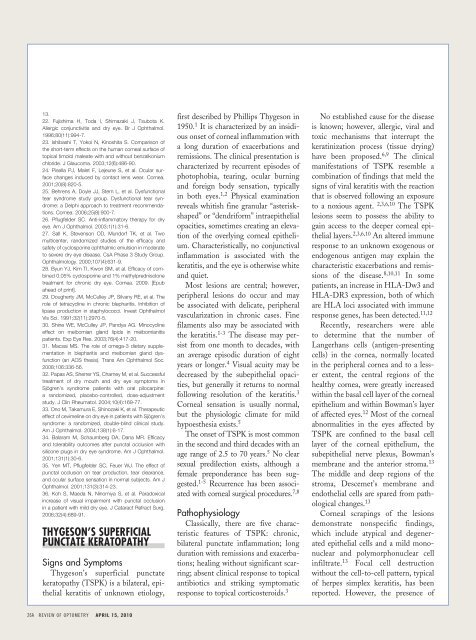Twelfth Edition - Review of Optometry
Twelfth Edition - Review of Optometry
Twelfth Edition - Review of Optometry
Create successful ePaper yourself
Turn your PDF publications into a flip-book with our unique Google optimized e-Paper software.
13.<br />
22. Fujishima H, Toda I, Shimazaki J, Tsubota K.<br />
Allergic conjunctivitis and dry eye. Br J Ophthalmol.<br />
1996;80(11):994-7.<br />
23. Ishibashi T, Yokoi N, Kinoshita S. Comparison <strong>of</strong><br />
the short-term effects on the human corneal surface <strong>of</strong><br />
topical timolol maleate with and without benzalkonium<br />
chloride. J Glaucoma. 2003;12(6):486-90.<br />
24. Pisella PJ, Malet F, Lejeune S, et al. Ocular surface<br />
changes induced by contact lens wear. Cornea.<br />
2001;20(8):820-5.<br />
25. Behrens A, Doyle JJ, Stern L, et al. Dysfunctional<br />
tear syndrome study group. Dysfunctional tear syndrome:<br />
a Delphi approach to treatment recommendations.<br />
Cornea. 2006;25(8):900-7.<br />
26. Pflugfelder SC. Anti-inflammatory therapy for dry<br />
eye. Am J Ophthalmol. 2003;1(1):31-6.<br />
27. Sall K, Stevenson OD, Mundorf TK, et al. Two<br />
multicenter, randomized studies <strong>of</strong> the efficacy and<br />
safety <strong>of</strong> cyclosporine ophthalmic emulsion in moderate<br />
to severe dry eye disease. CsA Phase 3 Study Group.<br />
Ophthalmology. 2000;107(4):631-9.<br />
28. Byun YJ, Kim TI, Kwon SM, et al. Efficacy <strong>of</strong> combined<br />
0.05% cyclosporine and 1% methylprednisolone<br />
treatment for chronic dry eye. Cornea. 2009. [Epub<br />
ahead <strong>of</strong> print].<br />
29. Dougherty JM, McCulley JP, Silvany RE, et al. The<br />
role <strong>of</strong> tetracycline in chronic blepharitis. Inhibition <strong>of</strong><br />
lipase production in staphylococci. Invest Ophthalmol<br />
Vis Sci. 1991;32(11):2970-5.<br />
30. Shine WE, McCulley JP, Pandya AG. Minocycline<br />
effect on meibomian gland lipids in meibomianitis<br />
patients. Exp Eye Res. 2003;76(4):417-20.<br />
31. Macsai MS. The role <strong>of</strong> omega-3 dietary supplementation<br />
in blepharitis and meibomian gland dysfunction<br />
(an AOS thesis). Trans Am Ophthalmol Soc.<br />
2008;106:336-56.<br />
32. Papas AS, Sherrer YS, Charney M, et al. Successful<br />
treatment <strong>of</strong> dry mouth and dry eye symptoms in<br />
Sjögren’s syndrome patients with oral pilocarpine:<br />
a randomized, placebo-controlled, dose-adjustment<br />
study. J Clin Rheumatol. 2004;10(4):169-77.<br />
33. Ono M, Takamura E, Shinozaki K, et al. Therapeutic<br />
effect <strong>of</strong> cevimeline on dry eye in patients with Sjögren’s<br />
syndrome: a randomized, double-blind clinical study.<br />
Am J Ophthalmol. 2004;138(1):6-17.<br />
34. Balaram M, Schaumberg DA, Dana MR. Efficacy<br />
and tolerability outcomes after punctal occlusion with<br />
silicone plugs in dry eye syndrome. Am J Ophthalmol.<br />
2001;131(1):30-6.<br />
35. Yen MT, Pflugfelder SC, Feuer WJ. The effect <strong>of</strong><br />
punctal occlusion on tear production, tear clearance,<br />
and ocular surface sensation in normal subjects. Am J<br />
Ophthalmol. 2001;131(3):314-23.<br />
36. Koh S, Maeda N, Ninomiya S, et al. Paradoxical<br />
increase <strong>of</strong> visual impairment with punctal occlusion<br />
in a patient with mild dry eye. J Cataract Refract Surg.<br />
2006;32(4):689-91.<br />
THYGESON’S SUPERFICIAL<br />
PUNCTATE KERATOPATHY<br />
Signs and Symptoms<br />
Thygeson’s superficial punctate<br />
keratopathy (TSPK) is a bilateral, epithelial<br />
keratitis <strong>of</strong> unknown etiology,<br />
26A REVIEW OF OPTOMETRY APRIL 15, 2010<br />
first described by Phillips Thygeson in<br />
1950. 1 It is characterized by an insidious<br />
onset <strong>of</strong> corneal inflammation with<br />
a long duration <strong>of</strong> exacerbations and<br />
remissions. The clinical presentation is<br />
characterized by recurrent episodes <strong>of</strong><br />
photophobia, tearing, ocular burning<br />
and foreign body sensation, typically<br />
in both eyes. 1,2 Physical examination<br />
reveals whitish fine granular “asteriskshaped”<br />
or “dendriform” intraepithelial<br />
opacities, sometimes creating an elevation<br />
<strong>of</strong> the overlying corneal epithelium.<br />
Characteristically, no conjunctival<br />
inflammation is associated with the<br />
keratitis, and the eye is otherwise white<br />
and quiet.<br />
Most lesions are central; however,<br />
peripheral lesions do occur and may<br />
be associated with delicate, peripheral<br />
vascularization in chronic cases. Fine<br />
filaments also may be associated with<br />
the keratitis. 1-3 The disease may persist<br />
from one month to decades, with<br />
an average episodic duration <strong>of</strong> eight<br />
years or longer. 4 Visual acuity may be<br />
decreased by the subepithelial opacities,<br />
but generally it returns to normal<br />
following resolution <strong>of</strong> the keratitis. 3<br />
Corneal sensation is usually normal,<br />
but the physiologic climate for mild<br />
hypoesthesia exists. 5<br />
The onset <strong>of</strong> TSPK is most common<br />
in the second and third decades with an<br />
age range <strong>of</strong> 2.5 to 70 years. 5 No clear<br />
sexual predilection exists, although a<br />
female preponderance has been suggested.<br />
1-5 Recurrence has been associated<br />
with corneal surgical procedures. 7,8<br />
Pathophysiology<br />
Classically, there are five characteristic<br />
features <strong>of</strong> TSPK: chronic,<br />
bilateral punctate inflammation; long<br />
duration with remissions and exacerbations;<br />
healing without significant scarring;<br />
absent clinical response to topical<br />
antibiotics and striking symptomatic<br />
response to topical corticosteroids. 3<br />
No established cause for the disease<br />
is known; however, allergic, viral and<br />
toxic mechanisms that interrupt the<br />
keratinization process (tissue drying)<br />
have been proposed. 6,9 The clinical<br />
manifestations <strong>of</strong> TSPK resemble a<br />
combination <strong>of</strong> findings that meld the<br />
signs <strong>of</strong> viral keratitis with the reaction<br />
that is observed following an exposure<br />
to a noxious agent. 2,3,6,10 The TSPK<br />
lesions seem to possess the ability to<br />
gain access to the deeper corneal epithelial<br />
layers. 2,3,6,10 An altered immune<br />
response to an unknown exogenous or<br />
endogenous antigen may explain the<br />
characteristic exacerbations and remissions<br />
<strong>of</strong> the disease. 8,10,11 In some<br />
patients, an increase in HLA-Dw3 and<br />
HLA-DR3 expression, both <strong>of</strong> which<br />
are HLA loci associated with immune<br />
response genes, has been detected. 11,12<br />
Recently, researchers were able<br />
to determine that the number <strong>of</strong><br />
Langerhans cells (antigen-presenting<br />
cells) in the cornea, normally located<br />
in the peripheral cornea and to a lesser<br />
extent, the central regions <strong>of</strong> the<br />
healthy cornea, were greatly increased<br />
within the basal cell layer <strong>of</strong> the corneal<br />
epithelium and within Bowman’s layer<br />
<strong>of</strong> affected eyes. 12 Most <strong>of</strong> the corneal<br />
abnormalities in the eyes affected by<br />
TSPK are confined to the basal cell<br />
layer <strong>of</strong> the corneal epithelium, the<br />
subepithelial nerve plexus, Bowman’s<br />
membrane and the anterior stroma. 13<br />
The middle and deep regions <strong>of</strong> the<br />
stroma, Descemet’s membrane and<br />
endothelial cells are spared from pathological<br />
changes. 13<br />
Corneal scrapings <strong>of</strong> the lesions<br />
demonstrate nonspecific findings,<br />
which include atypical and degenerated<br />
epithelial cells and a mild mononuclear<br />
and polymorphonuclear cell<br />
infiltrate. 13 Focal cell destruction<br />
without the cell-to-cell pattern, typical<br />
<strong>of</strong> herpes simplex keratitis, has been<br />
reported. However, the presence <strong>of</strong>





